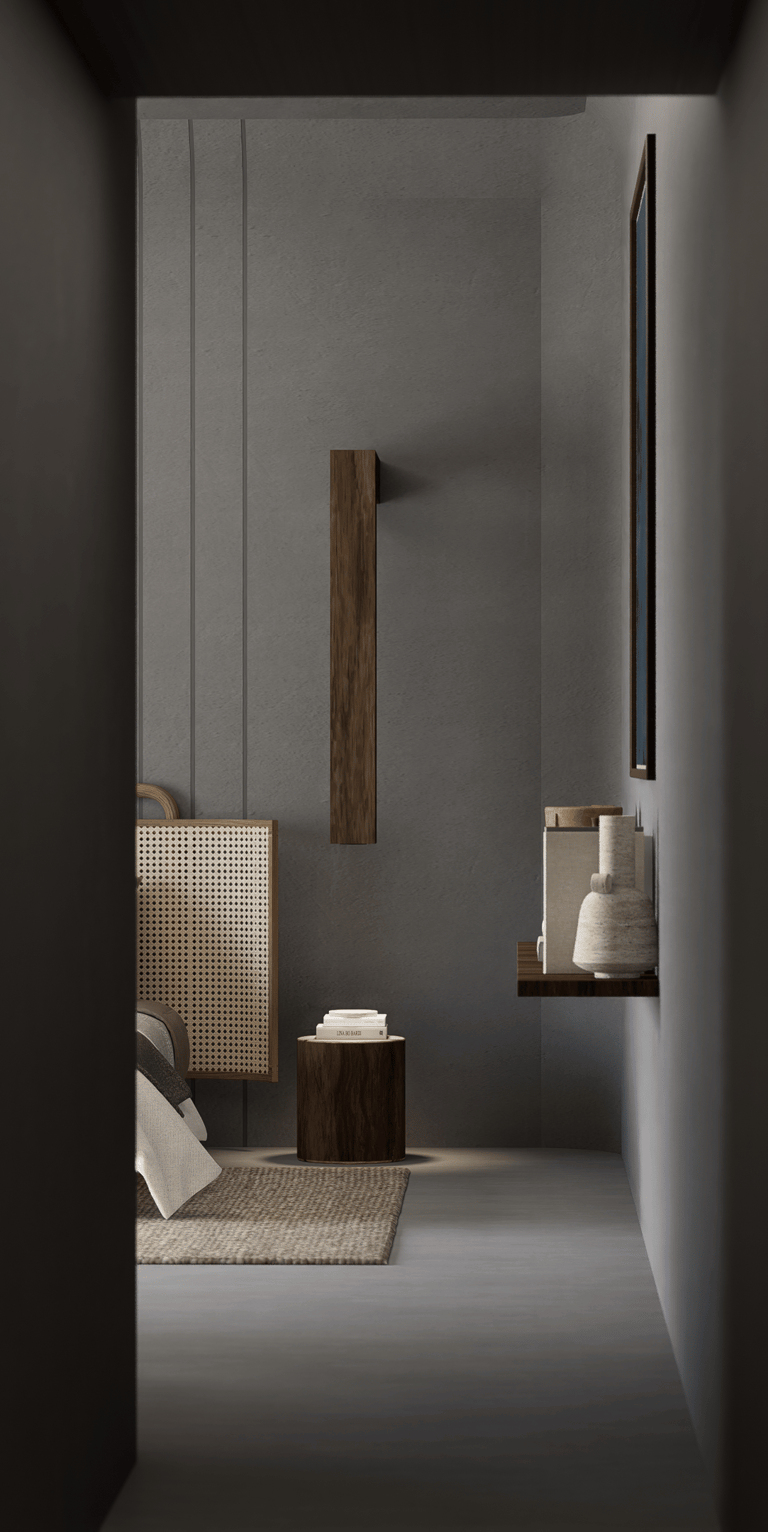The Desert Sanctuary: A Playbook for Climate-Intelligent Luxury

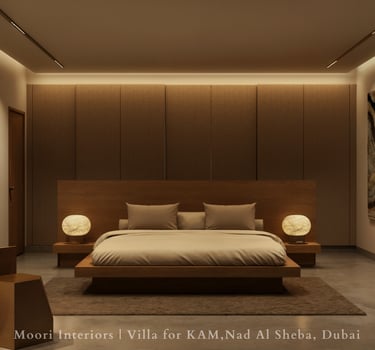
Introduction
In the desert, luxury begins with shelter. Walls that temper the sun, courtyards that capture breezes, and interiors that filter light into a soft, habitable glow are not only architectural gestures but instruments of well-being. The most successful villas are those that look effortless in 48°C heat, cool without excess, and age beautifully against sun, salt, and sand.
This is not a guide to "green checkboxes." Instead, it is a blueprint for a villa that feels extraordinary every day because its design is meticulously tuned to its environment- where comfort, elegance, and environment converge seamlessly.
The Principles of Desert Luxury
Principle I: The Intelligent Climate
The highest expression of luxury is effortless comfort. A villa engineered with thermal intelligence—one that is optimally oriented, meticulously shaded, and passively cooled—transcends the need for brute-force HVAC. It conserves energy as a byproduct of its serene, unruffled atmosphere.
Principle II: The Enduring Material
In this climate, materials reveal their worth. Stones, metals, and woods must withstand, not just impress. The choice between a corroded gate in five years or a bronze patina that grows richer is the choice between compromise and timelessness.
Principle III: Water as Conscious Abundance
A desert villa should choreograph water carefully—as reflection, as cooling, as ritual—never as waste.
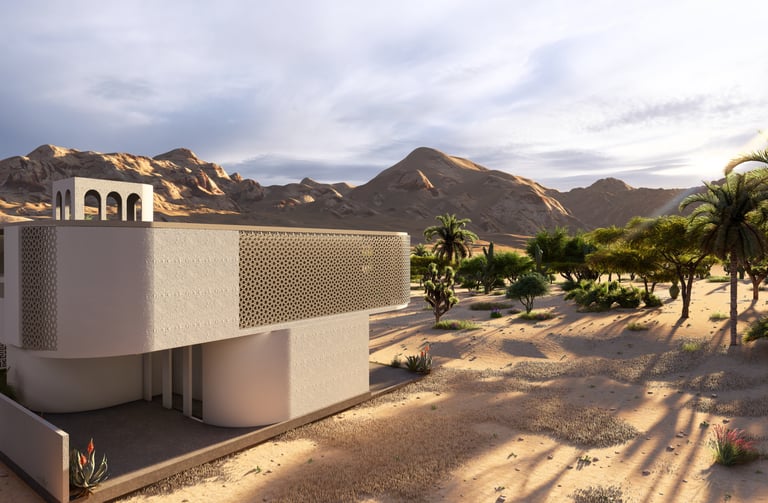

Designing the Desert Modern Villa
Phase I: Orientation & Massing
A villa’s first act of intelligence is how it meets the sun. Stretch it east-west, shield east/west walls, let north and south breathe. Shade is not accessory, it is architecture.
Phase II: The Courtyard as the Villa's Lungs
Courtyards are the lungs of the desert villa. Their proportions, shading, and water features make air move, soften light, and embrace outdoor life year-round.
Phase III: The Villa as a Thermal Battery
A villa’s envelope is its ultimate performance system. This goes beyond simple insulation. Multi-objective kinetic shading systems and thermochromic glass—materials engineered to dynamically adapt to the sun’s intensity—reduce solar heat gain in real time. Paired with a ventilated façade and high-albedo roofing, the villa becomes a thermal battery, intelligently managing heat transfer so interiors remain cool and comfortable with minimal energy.
Phase IV: Outdoor Living
In Dubai, outdoor spaces are no longer secondary—they are living, breathing extensions of the villa .Shaded corridors and narrow garden walkways, inspired by traditional Mediterranean and Arabian designs, create natural airflow that cools the villa. Stone benches, deeply recessed beneath pergolas, capture these breezes, offering comfortable retreats even at the peak of summer. Vertical greenery climbing walls and trellises provides additional shading, reduces solar gain, and softens the architectural envelope with living texture.
Water remains a central, choreographed element. Reflecting pools, fountains, and subtle channels echo the heritage of Arabian courtyards, cooling the air through evaporation while providing a gentle, rhythmic soundscape that enhances the sensory experience. Even minimal interventions, such as shallow channels along a pathway or a small sunken fountain, can transform a terrace into a tranquil microclimate.
Planting is equally purposeful. Native trees like the Ghaf provide shade, guide cross-breezes, and mark outdoor rooms, while drought-tolerant shrubs and desert herbs enrich both texture and scent. Every plant is chosen for performance and presence—creating a garden that feels lush and alive without excessive water consumption.
In this vision, the outdoor areas become true salons: spaces where guests linger, families gather, and the climate itself becomes a collaborator rather than an obstacle
The Unwritten Codes of Elevated Living
Beyond the physical blueprint, the following principles are the unwritten codes of a truly exceptional desert home. They are the quiet principles that guide how the house breathes, ages, and attunes itself to its inhabitants:
The Symphony of Air: Every aperture, vent, and threshold should be deliberately aligned to encourage cross-breezes and natural ventilation. Openings are placed not just for view but for performance—windows angled to capture prevailing winds, shaded screens that filter sand and glare, and vented clerestories that release warm air. This orchestration of flow keeps the interiors calm, temperate, and alive, reducing reliance on mechanical cooling while amplifying sensory comfort.
Circadian Harmony: Light is the most powerful regulator of human well-being. In a climate where the sun commands every rhythm, interior lighting must complement its cycles. Morning light should enter gently, filtered through screens or louvers; evening light should retreat, replaced by warm, dimmed illumination that signals rest. Tunable LED systems can replicate the sun’s spectral shifts, aligning artificial light with natural patterns to support energy, mood, and sleep. The result is a home that not only shelters life but synchronizes with it.
Graceful Resilience: True luxury reveals itself over time. Materials must be chosen for their dignity under pressure—the way bronze deepens, stone mellows, and wood silvers under the desert sun. Rather than resisting the climate, the villa’s surfaces collaborate with it, embracing patina and texture as measures of authenticity. A timeless home is one that endures without appearing defensive; its elegance lies in composure, not perfection.
Outdoor Respite: A well-designed villa creates a pocket of cool where you can enjoy the outdoors even at the peak of a summer afternoon. A "pocket of cool" is a meticulously engineered microclimate within the villa's footprint, designed to offer an escape from the midday sun. Examples of a "pocket of cool" include:
A deeply recessed loggia that benefits from the villa's own shadow, featuring a cooled stone bench for comfortable seating and discreet misting nozzles integrated into the ceiling.
A narrow, shaded courtyard where a small water feature or fountain provides a natural evaporative cooling effect, surrounded by heat-absorbing rammed earth walls and the fragrant shade of a native Ghaf tree.
A subterranean or semi-subterranean lounge, accessible from the main living area, that leverages the earth's natural thermal stability to create a consistently cool environment for reading or quiet contemplation.
Phase V: An Enduring Material Palette
Choose for permanence, not just appearance:
Stone & porcelain with integrity
316 stainless steel & marine-grade aluminum
Thermally modified wood, protected against desert UV
Beyond durability, the villa’s palette should echo the desert itself. Earthy tones—beiges, sands, and terracotta—can be woven into materials, furnishings, and finishes. These hues reflect the surrounding landscape, create a calming atmosphere, and deepen the villa’s connection to its environment
Phase VI: The Hydrological System
Rainwater is captured efficiently from roofs and terraces, stored in underground cisterns, and used to nourish gardens without disrupting the villa’s elegance. Invisible channels and flush thresholds ensure that rare but intense desert rains are managed gracefully.
Greywater from daily use is treated and recycled for irrigation or toilet flushing, creating a silent, self-sustaining loop that keeps the villa’s outdoor and indoor spaces lush and functional.
Gardens and courtyards are planted with drought-resistant natives—Ghaf trees, desert grasses, and aromatic herbs—that provide shade, guide airflow, and release subtle fragrances. Water features, from shallow fountains to reflecting pools, serve multiple purposes: passive cooling through evaporation, gentle soundscapes for the senses, and a visual rhythm that echoes the desert’s traditional architectural heritage.
In this way, the villa’s hydrological system transforms water from a resource into an integral part of the home’s identity—a functional, sensory, and ecological layer that reinforces both comfort and luxury.

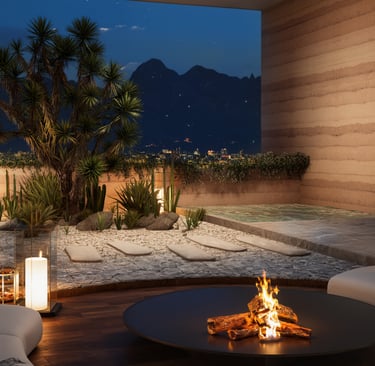
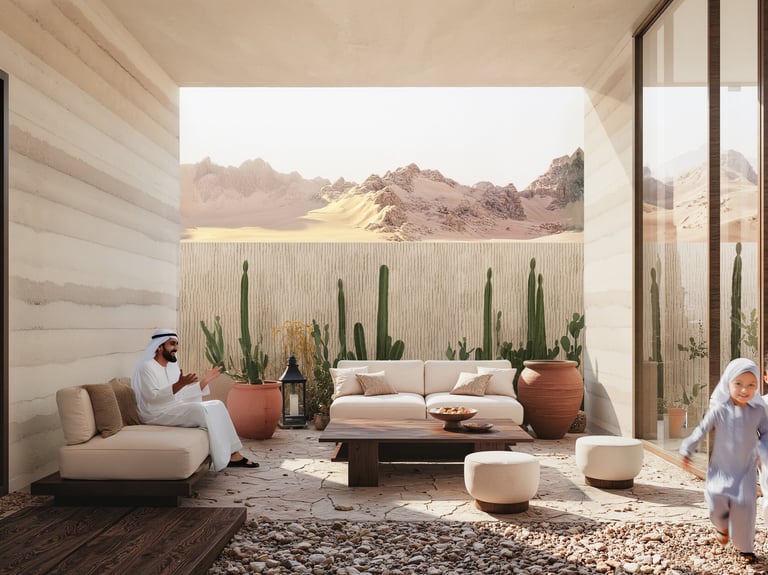

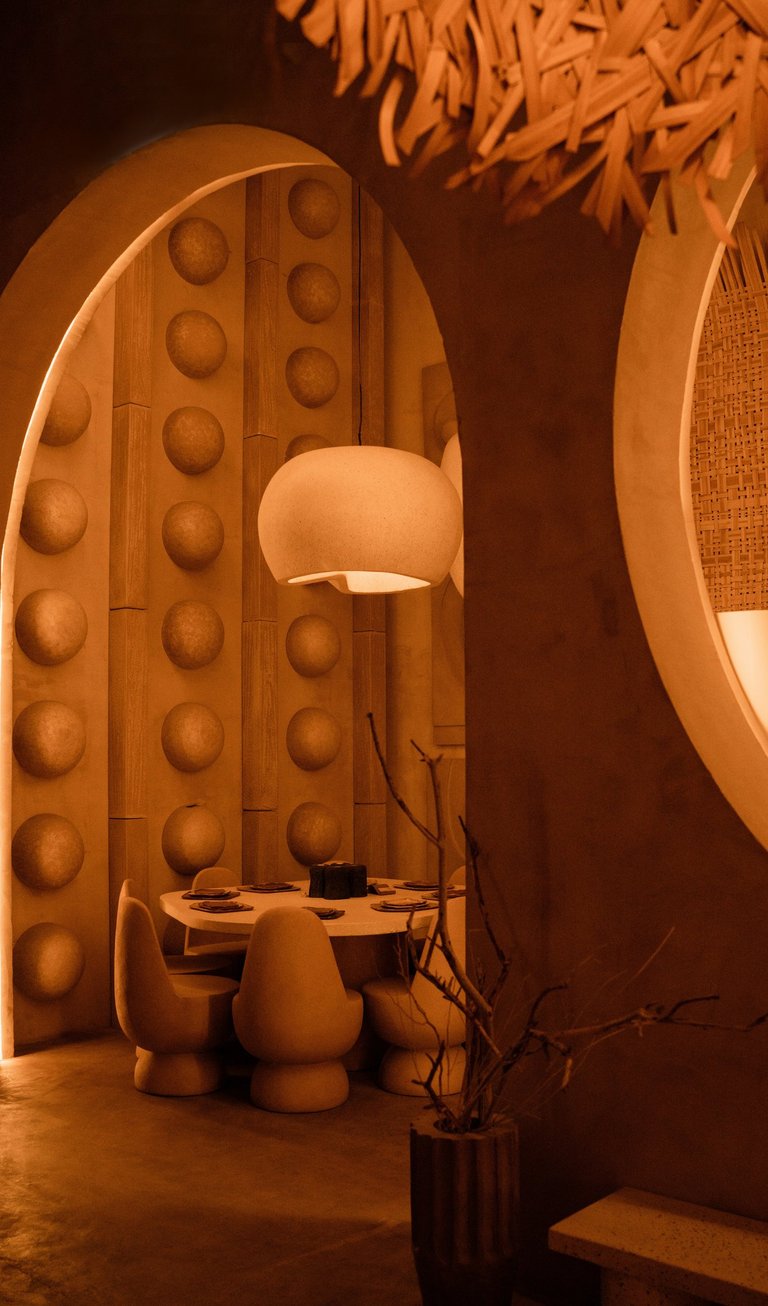

Closing Thought
A Desert Modern villa is not about resisting Dubai’s climate — it is about partnering with it. When massing, courtyards, materials, and water are intelligently orchestrated, the result is more than sustainability; it is elegance that endures. Wealth can buy finishes, but intelligence in design creates a home that lives well.

